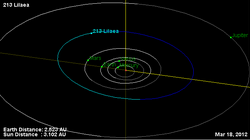Astronomy:213 Lilaea
From HandWiki
Short description: Main-belt asteroid
 Orbital diagram | |
| Discovery | |
|---|---|
| Discovered by | C. H. F. Peters |
| Discovery date | 16 February 1880 |
| Designations | |
| (213) Lilaea | |
| Pronunciation | /laɪˈliːə/[1] |
| Named after | Lilaea |
| A880 DA, 1950 TE3 | |
| Minor planet category | Main belt |
| Orbital characteristics[2] | |
| Epoch 31 July 2016 (JD 2457600.5) | |
| Uncertainty parameter 0 | |
| Observation arc | 136.08 yr (49704 d) |
| |{{{apsis}}}|helion}} | 3.1538 astronomical unit|AU (471.80 Gm) |
| |{{{apsis}}}|helion}} | 2.34961 AU (351.497 Gm) |
| 2.75172 AU (411.651 Gm) | |
| Eccentricity | 0.14613 |
| Orbital period | 4.56 yr (1667.3 d) |
| Average Orbital speed | 17.95 km/s |
| Mean anomaly | 199.50° |
| Mean motion | 0° 12m 57.312s / day |
| Inclination | 6.8028° |
| Longitude of ascending node | 122.113° |
| 162.34° | |
| Physical characteristics | |
| Dimensions | 83.01±2.6 km |
| Rotation period | 8.045 h (0.3352 d)[2][3] |
| Geometric albedo | 0.0897±0.006 |
| F[3] | |
| Absolute magnitude (H) | 8.64 |
Lilaea (minor planet designation: 213 Lilaea) is a large main belt asteroid. It was discovered by German-American astronomer C. H. F. Peters on February 16, 1880, in Clinton, New York and was named after Lilaea, a Naiad in Greek mythology.
Photometric observations of this asteroid in 1986 gave a light curve with a period of 8.045 ± 0.008 hours and a brightness variation of 0.20 ± 0.01 in magnitude. The curve is asymmetrical with two distinct minima. This object has a spectrum that matches an F-type asteroid classification.[3] As with C-type asteroids, its composition is primitive and rich in carbon.
References
- ↑ Noah Webster (1884) A Practical Dictionary of the English Language
- ↑ 2.0 2.1 Yeomans, Donald K., "213 Lilaea", JPL Small-Body Database Browser (NASA Jet Propulsion Laboratory), https://ssd.jpl.nasa.gov/sbdb.cgi?sstr=213, retrieved 12 May 2016.
- ↑ 3.0 3.1 3.2 di Martino, M. et al. (July 1995), "Intermediate size asteroids: Photoelectric photometry of 8 objects.", Astronomy and Astrophysics Supplement 112: pp. 1–7, Bibcode: 1995A&AS..112....1D.
External links
- The Asteroid Orbital Elements Database
- Minor Planet Discovery Circumstances
- Asteroid Lightcurve Data File
- 213 Lilaea at AstDyS-2, Asteroids—Dynamic Site
- 213 Lilaea at the JPL Small-Body Database
 |

